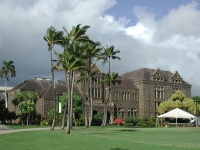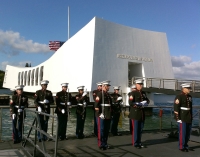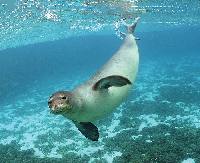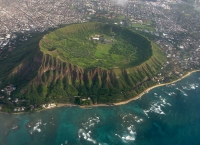City guides


Honolulu Travel Guide
Though Honolulu is an absolute wonderland of spectacular beaches, lush rainforests and breathtaking volcanic landscapes, it's far from the quiet and isolated resorts that many associate with the islands. Rather, Hawaii's capital is a bustling city of nearly a million people, where a glorious tropical climate and an intoxicating cosmopolitan energy give travellers plenty of opportunities to play.
The destination is essentially a microcosm of Hawaii. Visitors can spend their morning paddling a kayak or taking a surf lesson, shop 'til they drop in the boutiques of the Ala Moana Center, and attend a luau (a traditional Hawaiian feast featuring Native Hawaiian cuisine and traditional music) or take in a show at the Polynesian Cultural Center in the evening. The city itself has many attractions, and visitors will enjoy visiting the Waikiki Aquarium and Honolulu Zoo (both in Kapiolani Park), peering into Diamond Head Crater, and having fun on one of the many stunning beaches in Waikiki.
Honolulu has many excellent restaurants, a lively nightlife, and enough souvenir shops to satisfy even the most avid bargain-hunter. The hustle and bustle of the city may not be everyone's idea of a romantic holiday in Hawaii, but a few days in Honolulu is a must on any island getaway.
Things to do in Honolulu
Sunning and surfing on beautiful beaches, exploring the lively nightlife and shopping in a rich variety of neighbourhoods are among the many fun things to do in Honolulu, which is made up of the Waikiki, Downtown and Pearl Harbour areas.
Waikiki is a main tourist hub that draws travellers with its exquisite stretch of beach and picturesque shoreline. While visiting Waikiki, a stop at the Waikiki Aquarium is a must; not only is it one of the oldest aquariums in the US but it's also home to more than 3,500 plants and animals.
The Downtown neighbourhood is geared more towards history and culture, as its range of good museums, historic buildings and landmarks provides interesting sightseeing fodder. The USS Arizona Memorial is a must-see when in Honolulu as it allows for a look back in time to the tragedy of Pearl Harbour and America's entry into World War II. Another unique attraction, of a very different sort, is the Diamond Head Crater; this extinct volcano is one of the most famous landmarks in Hawaii.
Exploring Honolulu's Chinatown is a novel option and illustrates just how multi-cultural the Hawaiian islands are. Markets and restaurants in this vibrant neighbourhood sell all sorts of delicacies and visitors can view art, a dragon procession or even make an offering at a Buddhist temple.

Bishop Museum
The Bishop Museum in Honolulu is the largest museum in Hawaii and the premier natural and cultural history institution in the Pacific. Recognised worldwide for its cultural collections, research projects and educational programmes, the institution was founded in 1889 by Charles Reed Bishop in honour of his late wife, Princess Bernice Pauahi Bishop, the last descendant of the royal Kamehameha family of Hawaii. Originally, the museum housed the extensive family heirlooms of the royal family, but now the collection includes millions of artefacts, documents and photographs relating to Hawaii and other Pacific island cultures. It also has one of the largest natural history specimen collections in the world. All of these treasures are housed in the former Kamehameha School for Boys in Bernice Street, Honolulu, which was established by the princess, and moved to a new location in 1940.

USS Arizona Memorial Museum
The USS Arizona was one of several United States battle ships that were sunk by the Japanese Imperial Navy during its surprise historic attack on Pearl Harbour, Oahu, on December 7, 1941, causing the US to enter into World War II. The Arizona sank in about nine minutes, along with 1,177 sailors and marines who were on board. Visitors are carried by Navy shuttle boats to the unusual memorial centre, which has been constructed over the sunken hull that lies six feet (2m) below. The names of the dead are inscribed in stone inside the memorial. Visitors are shown a documentary film, and can view artefacts and exhibits explaining the tragedy. The memorial is open daily and is very popular. It's strongly recommended that visitors make advanced reservations online.
Honolulu's Chinatown
Visitors who enter Honolulu's Chinatown neighbourhood through the Gateway Plaza on the corner of Bethel and Hotel streets in the city's downtown business district will step into an exciting and exotic world made up of a colourful and eclectic blend of Southeast Asian cultures. Here Vietnamese, Laotian, Chinese, Japanese, Thai, Filipino, and a myriad of other ethnic groups work in harmony to sell their wares, serve their delicacies, and perpetuate their cultural traditions. The market sells an array of delicacies from noodles to duck eggs, and tantalising smells issue from the numerous inexpensive speciality restaurants in this 15-block area. Visitors can also consult an herbalist, view an art exhibit, watch a dragon procession, make an offering at a Buddhist temple, or perhaps buy a precious jade memento in this rich and memorable part of town.

Waikiki Aquarium
The award-winning Waikiki Aquarium in Honolulu is home to more than 3,500 plants and animals. One of the oldest aquariums in the United States, the facility is a great place to say hello to the colourful inhabitants of the Pacific Ocean, including zebra shark, giant octopus, monk seal, sea turtles, and giant clam. The aquarium offers classes and activities for children. These are very popular and must be booked in advance to avoid disappointment.

Diamond Head Crater
One of the most famous landmarks in Hawaii, Diamond Head dominates the landscape over Honolulu. Officially termed an extinct volcanic tuff cone, the mammoth cone is a US Monument and a popular attraction on Oahu. Located near resorts and beaches in Honolulu, Diamond Head has a hiking trail that takes roughly two hours to complete; while the trail is uneven and includes nearly 200 steps, the view of Oahu from the summit is well worth the effort. Hikers should bring plenty of water and protection from the heat, as there are no facilities along the trail, and the only comfort station is located at the base of the crater.
Eating Out
Honolulu offers diners anything and everything from the local and delightful to exquisite international cuisines. If home-grown and unassuming cuisine is what travellers are after, they'll find it in and around the city without too much effort.
Classic dining spots offering regional food at its best are the likes of Helena's Hawaiian Food, which is a famous eatery in and around Honolulu. Established in 1946, it still produces firm favourites for tourists and residents alike. Another popular spot in Honolulu is Uncle Clay's House of Pure Aloha. Friendly staff, a relaxed atmosphere and original snow cones are what keep people coming back.
If travellers want a truly luxurious experience, Honolulu happily caters to that too; many high-end restaurants are always abuzz in the city. Sushi Sasabune offers visitors a unique and upmarket sushi experience while La Mer ensures a breezy and romantic oceanside evening in a restaurant known for its impeccable service and French cuisine.
Nightlife
While many tourists think of Hawaiian nightlife as resort luaus (traditional Hawaiian feasts) with hula dancers and roast pigs, Honolulu offers a much more diverse experience for the adventurous visitor. Waikiki has a number of bars and restaurants ranging from friendly pubs to upscale nightclubs, and some host live music on various nights of the week. Chinatown is also a bustling neighbourhood after dark where there are a number of underground bars. Other great nightlife hubs in Honolulu include The Aloha Tower Marketplace, which has more than 60 restaurants and bars, and the Ala Moana Shopping Centre.
Getting Around
Getting around Honolulu, and Oahu in general, involves becoming familiar with local directions. Visitors may be told to go makai (toward the sea) or mauka (toward the mountain); the famous Diamond Head crater is also an important landmark and reference for the east, and the town of Ewa stands in for the west. The main public transport system is simply called The Bus, and serves Honolulu and most of Oahu. The bus network is comprehensive, with about 100 fixed routes and more than 4,000 stops allowing travellers access to all parts of the island. The most popular route runs between Waikiki and Ala Moana Center every 10 minutes. The Waikiki Trolley is also a fun way to get around Honolulu, as it loops around 12 key locations every 40 minutes with commentary by the driver. Taxis are also available and provide a good means of getting around at night; they're locally regulated so fares are standard across all companies. Uber and Lyft are also options.
Honolulu Climate and Weather
Honolulu experiences warm, balmy weather all year round as its tropical climate is subject to variations caused by different elevations and geographic exposure rather than seasons. Temperatures vary little throughout the year, averaging between 66ºF (19ºC) and 89ºF (32ºC). Located on the southern side of Oahu, Honolulu is drier than the leeward side, the rain-bearing trade winds blocked by the mountain ranges. The wet season in Honolulu is from October to March, and averages seven to 10 rainy days per month. The water temperature in Hawaii is warm year round, staying between 77°F (25°C) and 81ºF (27ºC).
United States of America travel info
Electricity
The electrical current is 120 volts, 60Hz. Plugs are mainly the type with two flat pins, though three-pin plugs (two flat parallel pins and a rounded pin) are also widely used. European appliances without dual-voltage capabilities will require an adapter.
Language
English is the most common language spoken but Spanish is often heard in the south-western states.
Money
The official currency is the US Dollar (USD), which is divided into 100 cents. Only major banks exchange foreign currency. ATMs are widespread and credit cards are widely accepted; Apple Pay and Google Pay are very popular. Banking hours are Monday to Friday 9am to 3pm.
Tipping
A 15 percent tip is expected by taxi drivers, bartenders, hairdressers and waiters, but travellers shouldn't tip in fast-food or self-service restaurants. In expensive restaurants or for large parties, the tip should be 20 percent of the bill. It's normal to tip staff such as valets and porters in hotels; this is discretionary, although a minimum of $5 is expected. Most services are customarily tipped if the service is good.
Health
There are no specific health risks associated with travel within the USA. Medical facilities are excellent, but expensive. Only emergencies are treated without prior payment and treatment can be refused without evidence of insurance or proof of funds. Good medical insurance is essential.
Safety
Travel within the United States is generally trouble-free, though travellers should be aware that the US shares with the rest of the world an increased threat from terrorist incidents. Security has been heightened, particularly at airports. Restrictions on hand luggage apply and travellers are advised to check on the latest situation with airlines in advance. Travellers should also be alert to the dangers of car and street crime in cities and should use common sense and take basic precautions. Hurricanes are common between June and November, putting the southern USA, including the Gulf Coast and the eastern US at risk. There's a risk of wildfires in many dry areas in the US, particularly on the West Coast from March to November.
Local customs
Laws vary from state to state, including speed limit, fines and punishment. The age at which alcohol may be legally bought and consumed is 21 years.
Doing business
In such a large country, filled with so many diverse groups, business practices may differ according to each state, though rarely to any large degree. The East Coast is traditionally more formal than the West Coast, though in states such as California, dress code and conservative appearance are as common as they would be in New York. Punctuality is important throughout the country and it's considered rude to be late for a meeting. Gift-giving is uncommon as it may be construed as bribery. Appropriate titles (Mr, Mrs, Ms) are used upon introduction and until otherwise stated. Americans favour politeness and greetings of 'Hello' and 'How are you?' are often expressed with sincerity. Business hours may vary in each state, but an 8am start and 5pm finish Monday to Friday is the most common with an hour over lunch.
Status and age are not necessarily indicative of seniority, nor do they carry much weight in themselves. Those doing business in the States should be mindful of this fact; foreigners should never make assumptions about someone's position or rank. Best practice is to be respectful to all parties. That said, the US upholds a hierarchal business structure in which 'the boss' is the ultimate decision-maker. Senior leaders have the power of the last word, and can go against the grain just as easily as they can follow popular opinion. Foreigners should concentrate on winning over this individual, even if the greater group seems unsupportive. Americans value a direct style of communication. In this fast-paced, consumer culture 'time is money', and small-talk is viewed as unnecessary and wasteful. It's best for foreigners to get to the point quickly, speak about issues in a frank and open manner, and to avoid taking offence if someone questions or challenges them outright.
Duty free
Travellers to the United States who are returning residents of the country do not have to pay duty on articles purchased abroad to the value of $800 provided their stay was longer than 48 hours and their duty-free allowance was not used in the 30-day period prior. For passengers arriving from Samoa, Guam and the U.S. Virgin Islands, a duty-free allowance of $1,600 is allowed. The following items are included in this: 50 cigarettes and 10 cigars and 150 millilitres (5 fl. oz.) of alcoholic beverages or 150 millilitres (5 fl. oz.) of perfume containing alcohol. Restrictions may apply to goods from Cuba, Iran, North Korea, Burma (Myanmar), Angola, Liberia and Sudan. It is prohibited to import Cuban cigars from any country.
Travellers to the United States who are non-residents do not have to pay duty on the following items: 50 cigars or 200 cigarettes and gifts to the value of $100 provided their stay in the USA is not less than 72 hours and that the allowance has not been used in the preceding six-month period.
Prohibited items for residents and non-residents include meat or meat products, poultry, narcotics, absinthe, plants, seeds, vegetables, fruits, soil, live insects and other living plants or animal pests. Fish is prohibited unless it carries disease-free certification. Wildlife and animals or their by-products carry restrictions. Dairy products and eggs from specified countries are not allowed. Firearms and ammunition are not allowed without the necessary license and permit.
Communications
The international country dialling code for the United States is +1. Mobile networks cover most of the country, especially all urban areas; travellers can purchase local prepaid SIM cards for unlocked phones or use eSIMs if their cellular providers support it on their networks. WiFi is widely available.
Passport & Visa
It is highly recommended that travellers' passports have at least six months' validity remaining after the intended date of departure from them travel destination. A visa is required for short visits unless travellers qualify for entry under the Visa Waiver Program.
The Visa Waiver Program (VWP) enables citizens of certain countries to travel to the US for a stay of up to 90 days without a visa. Visitors under the VWP need a valid Electronic System for Travel Authorization (ESTA), which allows the US government to screen all visitors before travel. Visitors entering the country under the VWP must have a machine-readable passport (MRP) that has a barcode on the photo page. Travellers under the VWP must have passports that include biometrics if they wish to enter the country without a visa, which means that passports must contain unique personal data such as fingerprints or iris details. All passports must contain a digital photo image in order to travel visa-free. All visitors to the USA have a photograph and two fingerprints taken by an inkless scanner on arrival, including those travelling visa-free under the VWP.
As part of the Western Hemisphere Travel Initiative (WHTI), all travellers travelling between the United States and Canada, Mexico, Bermuda, and the Caribbean region are required to present a passport or other valid travel document to enter or re-enter the United States. If departing from the USA, a valid passport is required by immigration authorities. Immigration officials often apply different rules to those stated by travel agents and official sources.
Entry requirements
US citizens require passports.
UK nationals require a passport valid for duration of stay. Most passport holders can get an Electronic System for Travel Authorisation (ESTA) through the Visa Waiver Programme, which allows travel to the US for up to 90 days. The VWP includes tourism, certain types of business visit and transit to another country.
The most important requirement on entering the U.S. is providing proof of Canadian citizenship. A valid Canadian passport is the best document to prove Canadian citizenship and the right to return to Canada. However, several other documents can serve, depending on the mode of transport. Generally, Canadian citizens do not require visitor, business, transit or other visas to enter the United States from Canada, though there are some exceptions.
Passports must be valid for the period of intended stay. If visiting the US for fewer than 90 days, Australian nationals may be eligible to apply for an Electronic System for Travel Authorization (ESTA), and enter under the Visa Waiver Program (VWP).
South Africans must hold a passport valid for duration of stay. A visa is required.
Passports must be valid for duration of stay. Irish nationals can get an Electronic System for Travel Authorisation (ESTA) under the Visa Waiver Programme for entry into the United States.
Passports must be valid for duration of stay. New Zealand nationals can get an Electronic System for Travel Authorisation (ESTA) under the Visa Waiver Programme for entry into the United States.
Useful contacts
United States Tourist Office: www.usatourist.com
911 (General)Embassies / consulates in other countries
United States Embassy, London, United Kingdom: +44 20 7499 9000.
United States Embassy, Ottawa, Canada: +1 613 688 5335.
United States Embassy, Canberra, Australia: +61 2 6214 5600.
United States Embassy, Pretoria, South Africa: +27 12 431 4000.
United States Embassy, Dublin, Ireland: +353 1 668 8777.
United States Embassy, Wellington, New Zealand: +64 4 462 6000.
Embassies / consulates in United States of America
British Embassy, Washington DC: +1 202 588 6500.
Canadian Embassy, Washington DC: +1 202 682 1740.
Australian Embassy, Washington DC: +1 202 797 3000.
South African Embassy, Washington DC: +1 202 232 4400.
Irish Embassy, Washington DC: +1 202 462 3939.
New Zealand Embassy, Washington DC: +1 202 328 4800.


